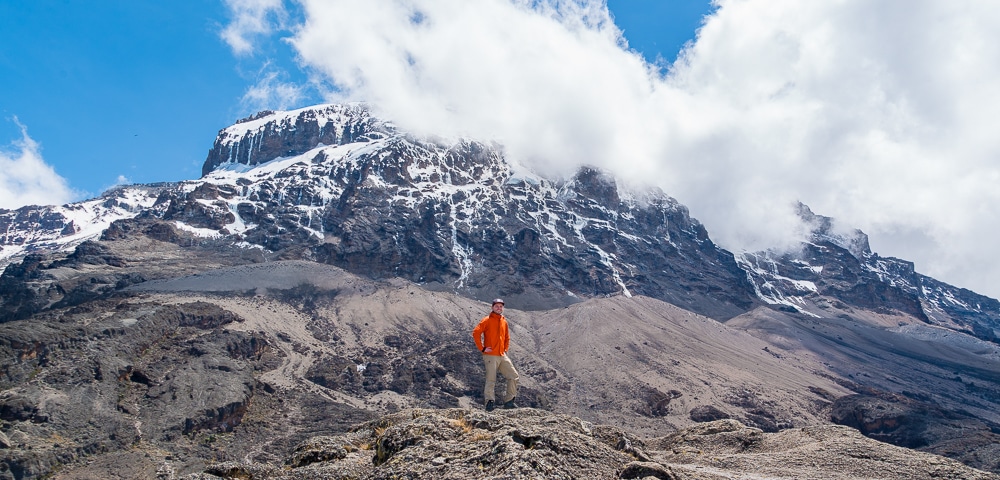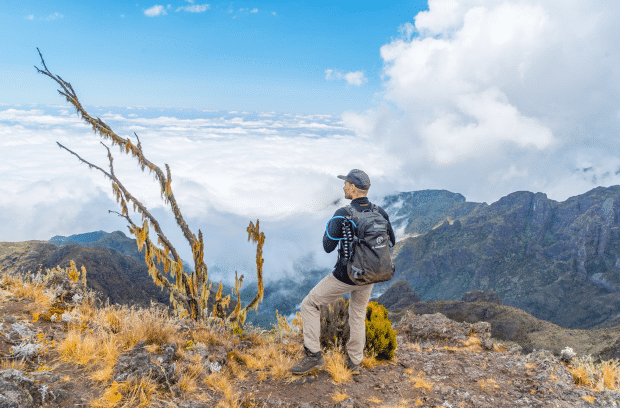In this article I gathered my best Kilimanjaro tips in order to plan your very own trip to the highest mountain in Africa (5895m). Based on my experience trekking the 8 day lasting Lemosho route this Kilimanjaro guide provides all information needed for your own Kilimanjaro trekking adventure.
I hiked up Mt. Kilimanjaro in late September/early October in order to produce a video documentary about the adventure as part of my brand ambassadorship with G Adventures. Use the following navigation to jump to the Kilimanjaro tips you are most interested in:
(use the anchor links to jump to the section, use „Top“ to get back to this menu)
- Weather & Best Time to go
- Routes & Itineraries
- How to choose a tour company
- Visa & Insurance
- Altitude Sickness
- Training & Diet
1) Best Time to Climb Kilimanjaro
First of all I want to make clear that we are talking about a pretty high mountain. As you know the weather in the mountains is very hard to predict and can often change very quick. In fact the temperature on the summit of Kili is usually below freezing, which means that you can face temperatures of -20°C on Uhuru Peak while having about +30°C down in Moshi. No matter which time of the year: you should always come well prepared.
There are different seasons in Tanzania but not like the winter & summer season as we know it from Europe or North America. Due to its proximity to the Equator the year is divided into wet and dry season. Therefore the best time to climb Kilimanjaro is during the dry season between August and October as rainfall during that time is at its lowest and you have the highest chance of having clear views to and from the mountain. On the flip side said months are also the high season on the mountain which means it is also the busiest time of the year (by choosing a longer, less popular route it'll be more relaxed!).
Though it is the time with least crowds one of my Kilimanjaro tips would be to avoid the wet season from March-May and in November as bad weather drains your energy and therefore reduces your chances of making it to the top. Your best bet if you want to avoid the masses is therefore the shoulder season in early July and December(except for the time around christmas/new years), the time from January to February is still popular as the temperatures are higher but the chances of rain for both timeframes are about 50/50.
| Month | Temperature | Precipitation | Cloudiness | Crowds |
|---|---|---|---|---|
| January | Warm | Medium | Low | High |
| February | Warm | Medium | Low | High |
| March | Moderate | High | Medium | Low |
| April | Moderate | High | High | Low |
| May | Moderate | High | High | Low |
| June | Cold | Medium | Medium | Medium |
| July | Cold | Medium | Low | High |
| August | Cold | Low | Low | High |
| September | Moderate | Low | Low | High |
| October | Moderate | Low | Medium | Medium |
| November | Moderate | High | Medium | Low |
| December | Moderate | Medium | Medium | Medium |
2) Routes & Itineraries
Being one of the most popular mountains in the world, roughly 50,000 trekkers every year try to reach the summit of Mt Kilimanjaro. According to research published by the Climb Kilimanjaro Guide, the average summit success rate across all climbers and routes is 65%. However, summit success rate heavily depends upon what route is climbed as routes vary considerably in terms of acclimatization profile and duration of climb.
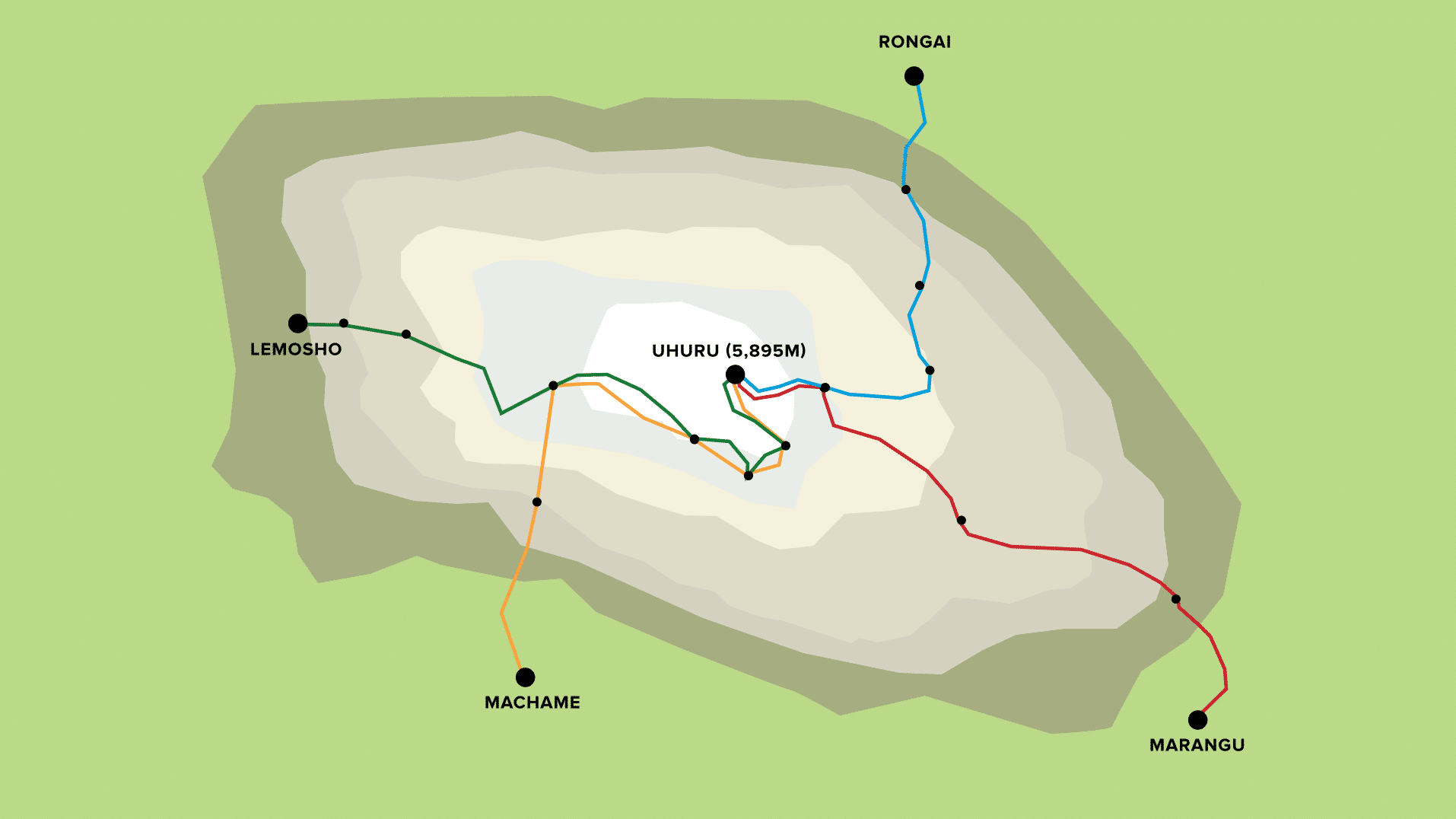
To get to Uhuru Peak there are several routes and itineraries to choose from:
- Marangu Route: The most popular but very crowded one is the 5-6 day Marangu route (often referred to as “Coca Cola” route) with 64km where you can sleep in basic huts. Though you don't need to camp those huts are anything but luxurious as you get to sleep in huge dorms together with many trekkers
- Rongai Route: often described as the hardest the 65km long Rongai route is the only one which approaches Kilimanjaro from the north and takes 6 days
- Machame Route: this is the second most popular route and takes usually 7 days. The route is 49km long, approaches the mountain from the West and offers some beautiful panoramic views
- Lemosho Route (my route): I decided to take on the Lemosho route which is 56 kilometers long and takes altogether 8 days
One of my best Kilimanjaro tips is to take a longer route as you have much better chances of acclimatizing your body to the high altitude. Trekking in such a high altitude should be seen as a marathon, not a sprint as there is no reason to rush for this once in a lifetime experience. Therefore I chose to do the Lemosho route which features a few acclimatization hikes along the way resulting in a very high summit success rate (in case of G Adventures it is at 96%!).
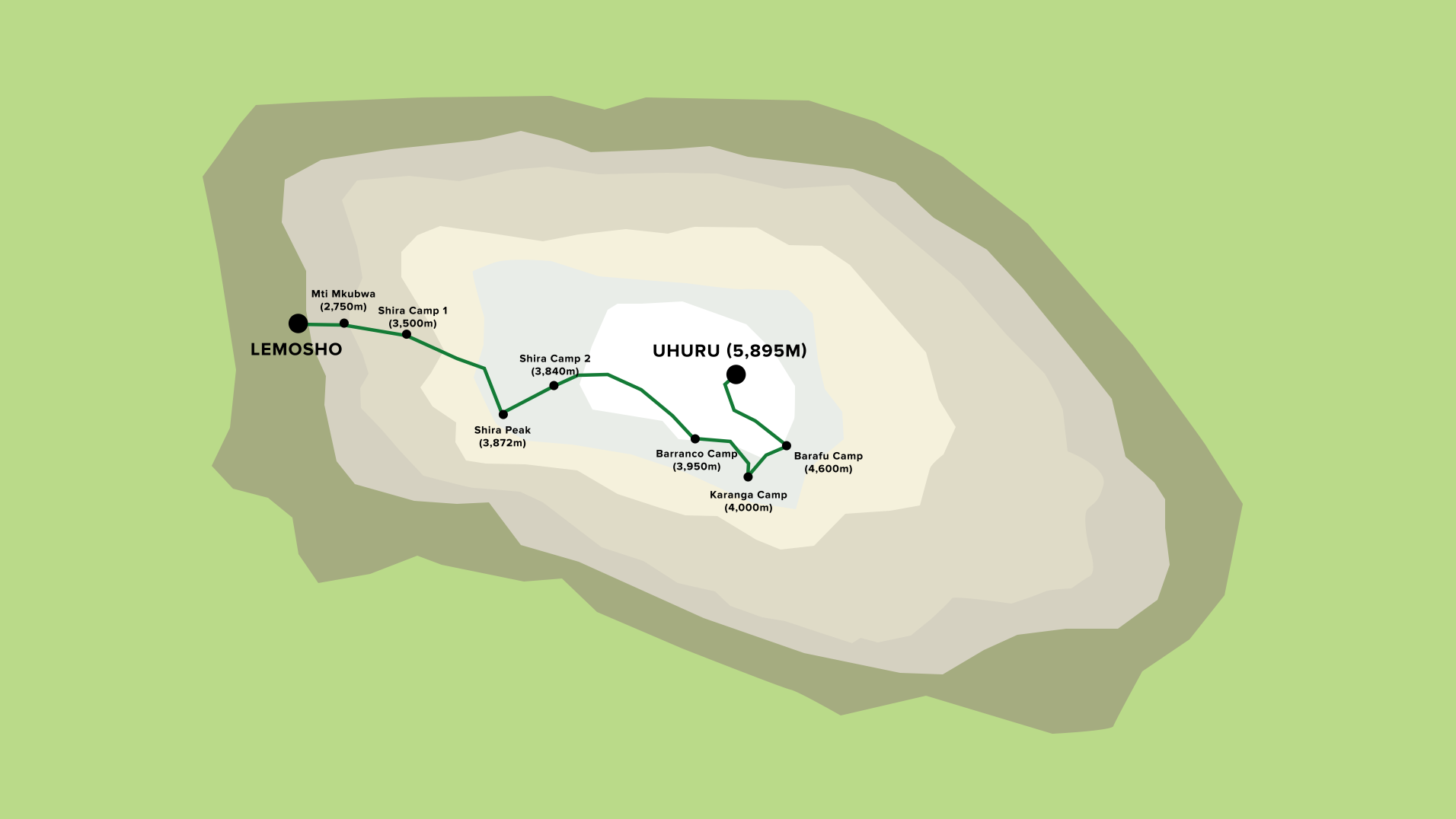
Another reason why you should look into the longer routes is the fact that those which approach the mountain from the West (Lemosho & Machame) offer simply more picturesque views than those which go straight up. On the Lemosho route for instance you first hike through the jungle up to the Shira plateau with an extra hike to the top of Shira (one of 3 craters on Kili) from where you can see the beautiful valley below before tackling the Lava tower, the impressive Barranco wall and finally heading up into the alpine desert zone.
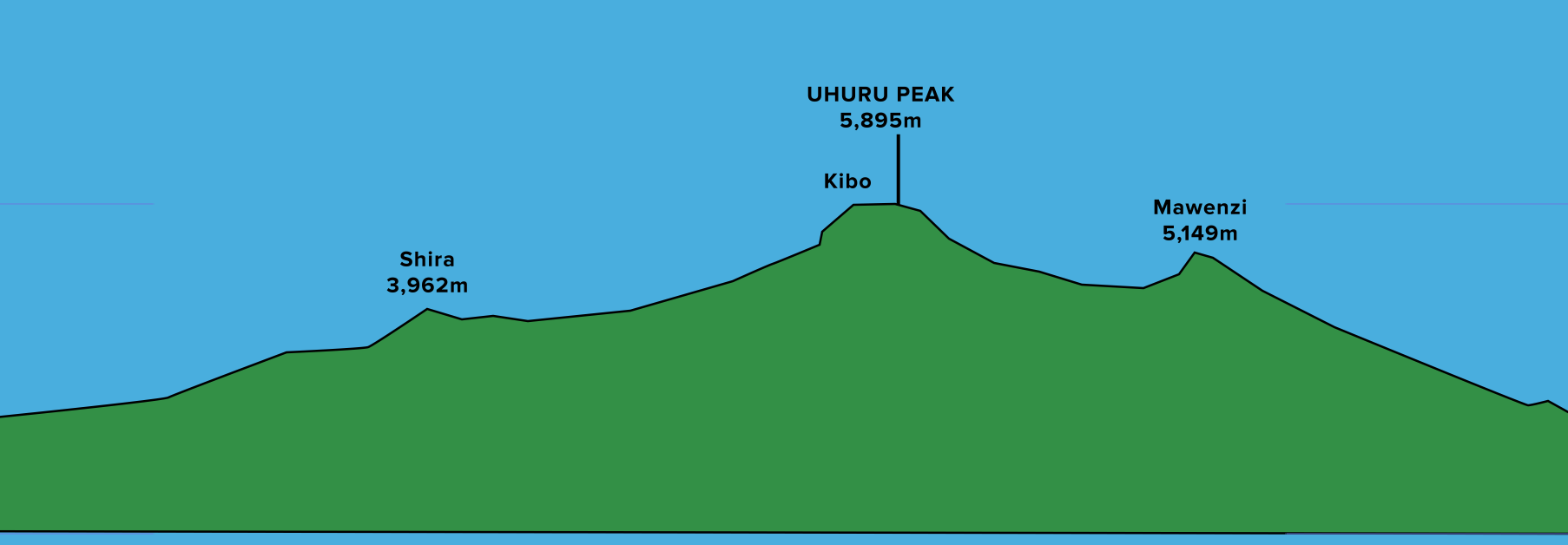
For me the locations of the camps have been another highlight – mostly in front of Kibo with incredible views over colorful tents down to an ocean of clouds and Mt. Meru peaking out. I always set my alarm early to take in those magical sunrise moments before having breakfast with the group!
3) How to choose the right tour company
In order to trek on Mt. Kilimanjaro you need to go with a registered trekking company, a certain amount of porters and guides. Climbing Kilimanjaro independently is not possible, mainly because tourism on the mountain is the biggest job creator in Tanzania.
The mountain itself and its surrounding areas are within the limits of the Kilimanjaro National Park. The fees for the park as well as the camps are pretty high and add up to about 800-1000 $ per person, depending on duration and route. Those costs are already included in the tour and make up almost half of the overall tour price – the rest will be used for wages, food, equipment and transport.
Before booking a tour you should always do some research (e.g. online in forums & reviews) in order to make sure that the company:
- pays fair wages to their employees
- uses good equipment
- …and has the experience needed
Even though you might find some cheap tour offers online: as a rule of thumb I highly encourage you to focus on is to look within the mid-tier price range between 2.000-3.500 $ depending on the route you choose in order to guarantee a good experience for everyone involved.
Because I'm a brand ambassador for G Adventures and was shooting a documentary I went with G Adventures – but even without this cooperation I can highly recommend their tours as they only work with local employees and suppliers, use up to date equipment (in fact our tents were brand new) and treat their employees very well. Just one example: I noticed that a lot of porters on the mountain had worn out shoes while our porters all had proper hiking boots. The guides we had have been on the mountain between 70 and 170 times. Tours start at 2,500 $ (if there is a Sale you can get 20% off!) and even include the hotel stays before and after the hike.
Additional Kilimanjaro Tip: When you have your briefing the day before you start trekking I highly recommend to opt in to have own toilets for your group as the public toilets in the camp are usually very crowded and quite gross (some of my fellow hikers referred to it as “one of the best decisions we made!”).
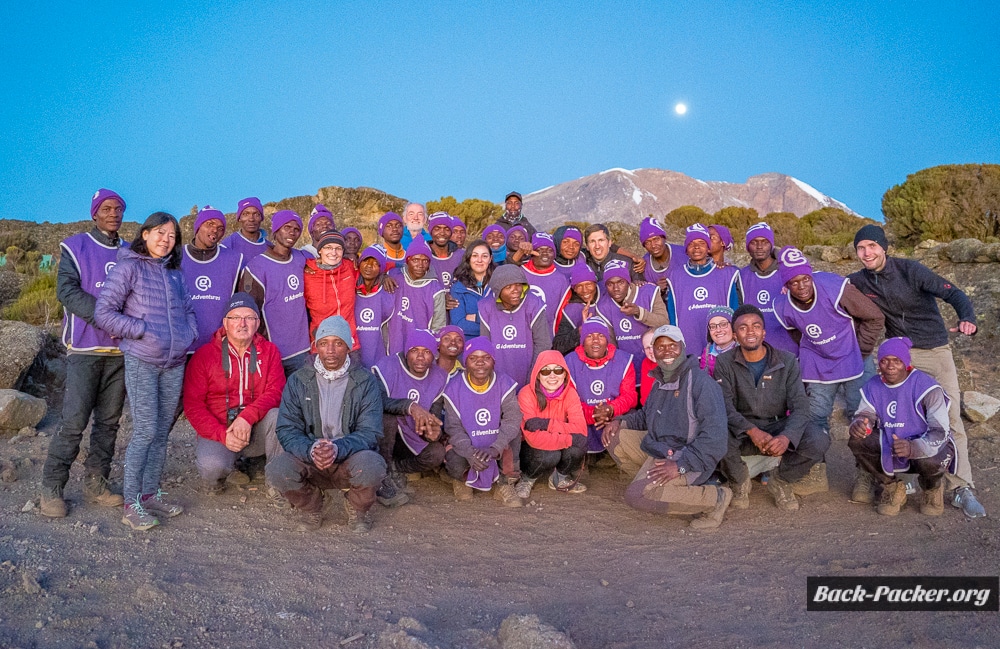
4) Visa & Insurance
In order to enter Tanzania you'd need a Visa for the duration of your stay. In most cases you can easily get a Visa upon arrival at the airport, like I did. Nevertheless regulations can often change quickly and I highly advice on checking with your Ministry of Foreign Affairs about Visa regulations for your country:
Having Travel Insurance is mandatory in order to join a trekking tour (at least for those companies who care for your safety). I always advise on getting travel insurance as it is important to have you covered in case anything happens throughout your trip (Believe me I have seen many people being carried down the mountain on stretchers due to High Altitude Sickness). I recommend the insurance by WorldNomads which has always been a reliable choice on my travels as it covers outdoor activities.
5) Altitude Sickness
When climbing Kilimanjaro almost everybody has to deal with syndromes of Altitude Sickness to some extinct – which makes trekking up that mountain such a challenge. To put things into perspective: the amount of Oxygen on the top is only 50% compared to the amount of Oxygen you are used to have. These circumstances can even lead to acute mountain sickness which is life threatening and causes the majority of deaths on Kilimanjaro.
No matter how old, fit or strong you are and even if you have been in high altitude without problems before: altitude sickness can get you any time. Therefore the only way to prevent it is to let your body adjust slowly to the altitude by doing a gradual ascent and to drink loads of water every day (3-4l during your hike each day, the best kilimanjaro tips from my guides to cope with the altitude!). On top of that I recommend paying attention to your body signals and having experienced guides to monitor your health conditions during your ascend.
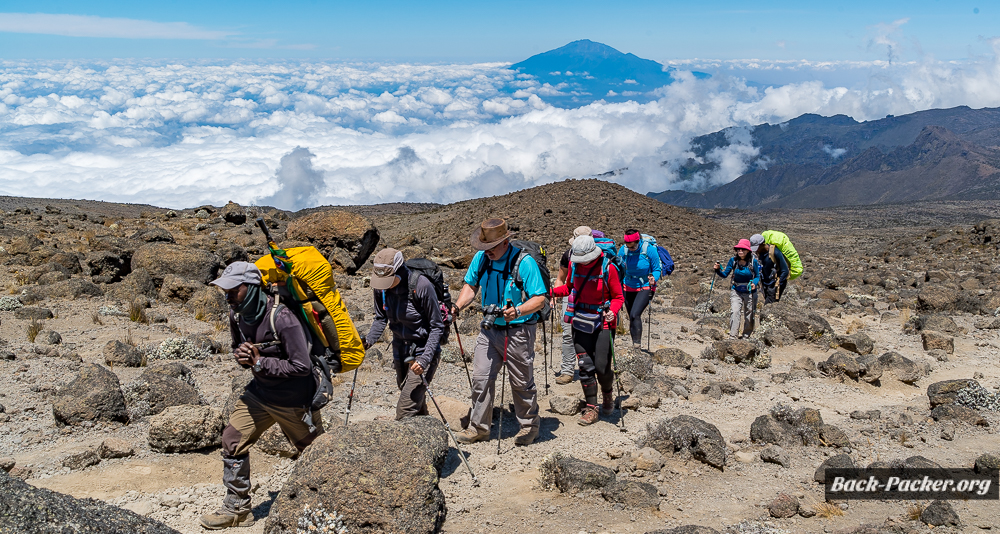
As stated earlier I chose the Lemosho route to give my body the time needed to adjust – with a much slower ascend and several acclimatization hikes I was able to summit in the end. Even though I had symptoms of altitude sickness my guides allowed me to summit because they did check my oxygen levels as well as pulse rate regularly and checked in with me every half an hour during the summit night. At the same time our guides made clear that we wouldn't be allowed to summit if certain severe symptoms would occur – we even had bottled oxygen with us in case of an emergency. Unfortunately those safety measures aren't in place for all tours on Kili due to the fact that they add costs to the tour price, therefore you should choose your tour operator wisely!
Additional Kilimanjaro Tip: Medicine to fight Altitude Sickness isn't as effective as it claims to be and affects people differently. In general our guides recommended to avoid taking pills like Diamox for the trek as the side effects could actually do more harm. Instead I took headache pills with me and used them only as a stand-by medicine on the summit day.
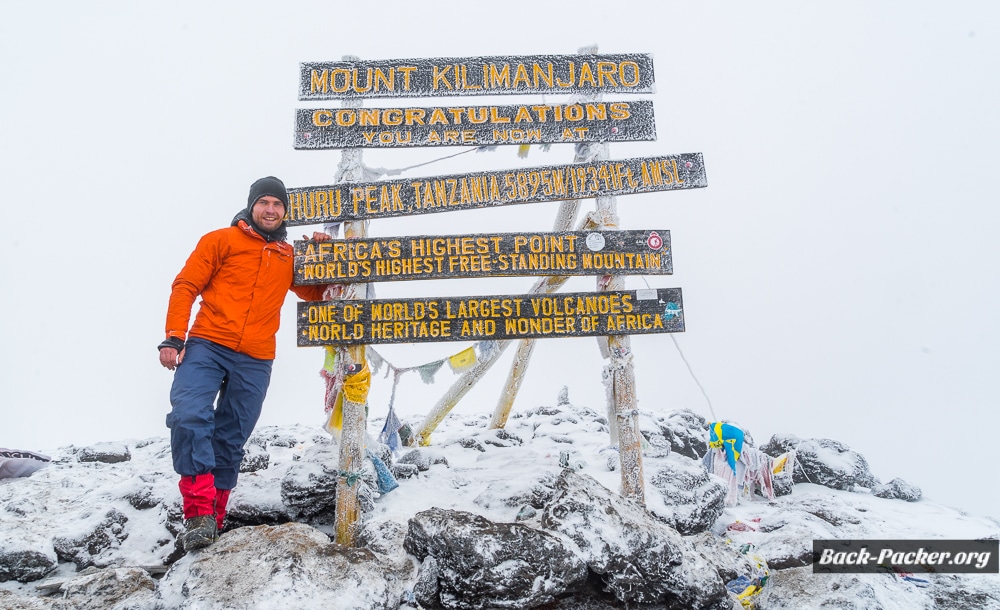
6) Training & Diet
Another reason why I could summit even though I suffered from altitude sickness was the fact that I prepared properly for Climbing Kilimanjaro. First and foremost I worked on my general fitness by running about 10km on 2 days and later 4 days a week for the course of 6 months. This endurance training was key in order to strengthen my body and made the difference during summit night as I was physically strong enough to push myself up there (and down) without needing the help of others. Working on your fitness is one of the most important Kilimanjaro tips. If you have mountains nearby that's even better – use them as your workout terrain!
I also decided to change to a healthier diet (nutrition mainly based on vegetables, fruits mixed with carbs once a day) in order to strengthen my immune system and to have a healthier lifestyle in general. I believe this also helped me to not get sick in the preparation process, so my workout routine didn't get interrupted. On top of that I even quit alcohol for several month, one thing I always wanted to try out .
The combination of a more healthy diet and a regular workout program in the months leading up to my big trek made it not only possible to climb Kilimanjaro – with this I was also able to truly enjoy the hike and to film a whole documentary while many other less prepared trekkers suffered even days before summiting.
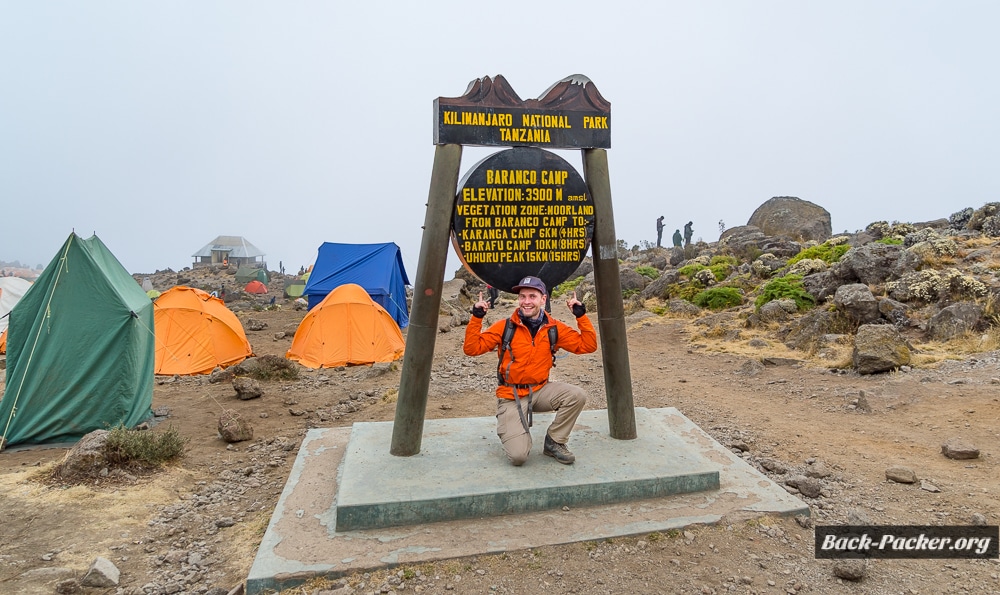
7) Malaria & Vaccination
When traveling to Tanzania you need to keep in mind that there is a risk of malaria throughout the year in the whole country. Malaria is a serious and occasionally fatal disease that is spread by mosquitoes. As there is no vaccine against malaria you can only protect yourself by avoiding mosquito bites and consider taking antimalarial medication. Therefore I highly recommend talking to your doctor a few weeks in advance to determine if and which medication is the right one for you.
As I was only traveling to Tanzania for the trek and flew out straight after the tour ended I checked with my doctor and he gave me a prescription for Malarone to use as a stand-by medicine. Usually mosquitos are only present up to an altitude of 2,000m, therefore the highest risk would be before and after the trek. I highly advice to wear long pants and insect repellant before and after the trek – most hotels also have mosquito nets (if you want to be on the safe side you can take one with you).
In matters of Vaccination you need to have Yellow Fever protection if you are coming from or have transited through an airport of a country where yellow fever occurs. Apart from this you should make sure that your routine vaccines are up-to-date and to have a travel insurance that covers you in Tanzania (see (4) above for my recommendation). Please also make sure to read the latest health travel advices and travel warnings from your respective Ministry of Foreign Affairs:
- Foreign travel advice for German citizens
- Foreign travel advice for US citizens
- Foreign travel advice for Canadian citizens
- Foreign travel advice for UK citizens

8) Gear & Equipment
Good news is that all treks on Kilimanjaro are organized tours where you'll have porters to carry most of your equipment. But this also means that you need to focus on the essentials as there are (luckily) restrictions on the weight each porter is allowed to carry. Altogether you’ll need to prepare for all climate zones as you’ll be starting the trek in the warm jungle (30°C) and hopefully finish on the top where you’ll have freezing temperatures up to -20°C.
Most tour operators will provide the majority of the camping equipment (personal tent, mattress, cutlery, dining tent with camping chairs and tables ) needed and/or will have the possibility to rent additional gear (sleeping bag, water bottles).
To make it even easier for you I put together a comprehensive Kilimanjaro Packing list with all my Kilimanjaro tips regarding equipment to help you prepare for your trek:
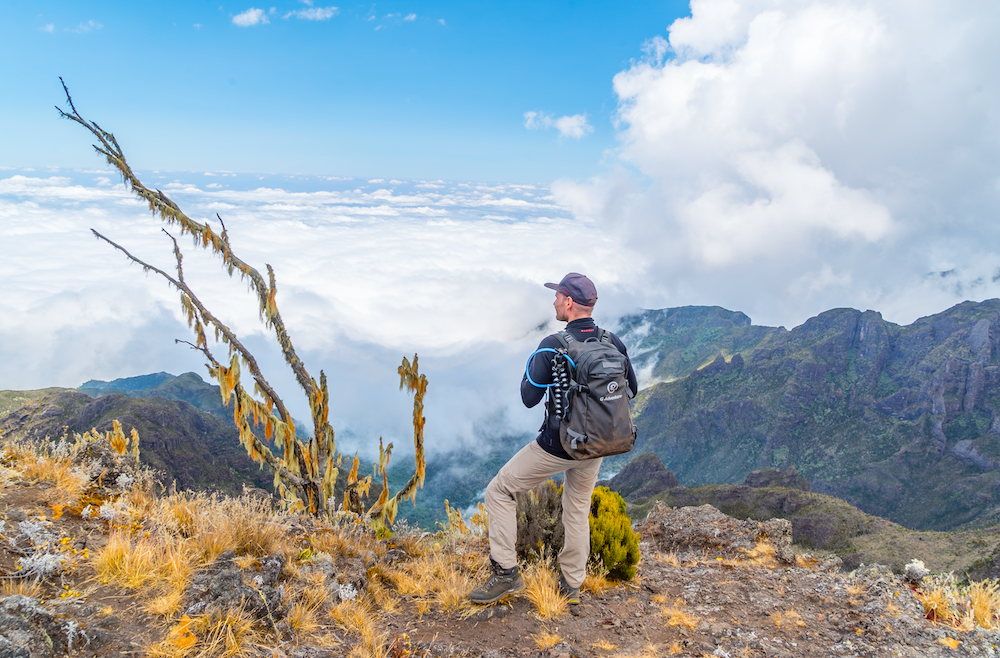
9) Get In & Around
In most cases your adventure will start in the area of Moshi/Arusha. The airport to fly in to is located just in between both cities and is called Kilimanjaro International Airport and you will most likely be staying in a hotel just a 30 min drive away. I flew with KLM from Amsterdam directly to Moshi – on the way back to Amsterdam there is a short stopover in Daressalam where you stay seated.
In order to get to your hotel and back to the airport one of my Kilimanjaro tips would be to organize a private transfer with your tour operator. The transfers to the starting point of the trek as well as to the hotel after finishing the trek are most likely included in your tour (best to check with your tour operator).
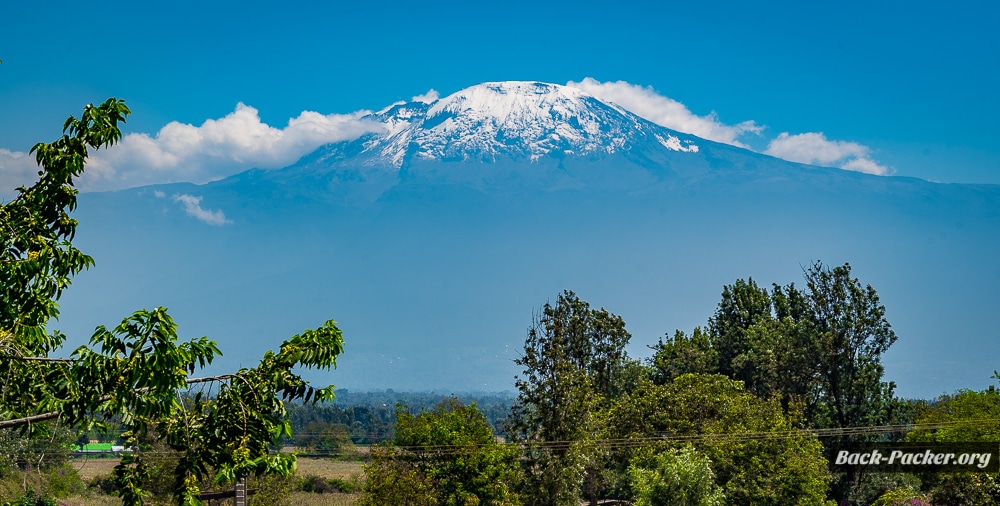
10) Money & Tipping
If you are not planning to stay longer in Tansania you actually don’t need to bother getting the local currency as US$ are widely excepted in the area – the same goes for tipping. Therefore I only brought US$ to pay some meals in the hotel before and after the trek as well as for the tips of the crew.
Tipping is a very important part of the salary for the local guides, porters, chefs and drivers who are the ones that make your trip possible. Of course it is always up to you how much you tip and it should also reflect your experience. The general guideline is to calculate with round about 10% of your tour price as the total tipping money for each trekker. I also decided to give a few gear items (gators, gloves) to some of the porters who were helping me carry parts of my camera equipment throughout the trip which was highly appreciated.
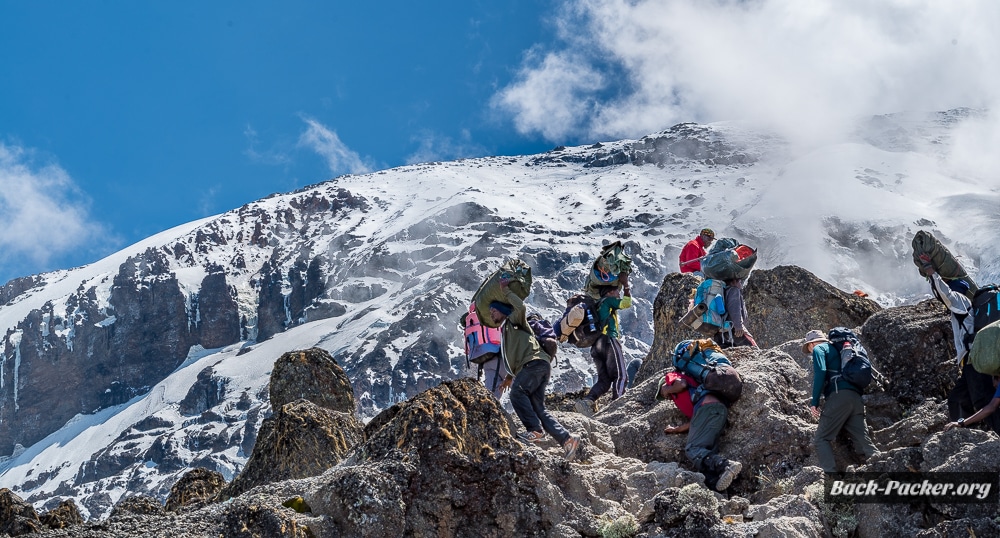
11) Recommended Tours
As stated multiple times you need to book a tour in order to climb Kilimanjaro and you should choose your tour operator wisely. This way you do not only leave the organization of the trip including all meals, campsites and transport to local experts but you get to learn so much about the area from your guides and you'll travel in a group of like-minded people.
After working with them in Peru and Cuba I highly recommend the small group tours offered by G Adventures as their philosophy (working with small local businesses) and focus on sustainable, responsible travel are in line with my personal values (on top of that they support a local community project in Moshi). With many years of expertise you can expect well organized, fun trips in small groups:
- Lemosho Route (10 days / 8 days of trekking): this is the guided multi-day trek I did and can highly recommend in order to enjoy the best views and have the best acclimatization chances. You'll start trekking in the jungle and finish on the white Uhuru Peak. The price includes accommodation before and after the trek, camps, meals, transfers, porters, equipment (tent, mat, chair, table, cutlery) and local guides.
- Machame Route (9 days / 7 days of trekking): if you have less time the Machame route offers a similar experience to the Lemosho route as it approaches the mountain on a shorter, parallel trail. The price includes accommodation before and after the trek, camps, meals, transfers, porters, equipment (tent, mat, chair, table, cutlery) and local guides.
- Rongai Route (8 days / 6 days of trekking): the Rongai route offers a unique way of approaching the summit as it is the only route on the northern side of the mountain. The price includes accommodation before and after the trek, camps, meals, transfers, porters, equipment (tent, mat, chair, table, cutlery) and local guides.
- Marangu Route (7 days / 5 days of trekking): if you are on a budget this route is your best bet but it is also a true challenge as you'll have a fast pace and not much time to acclimatize your body. One advantage is that you get to sleep in huts (very basic!) rather than tents. The price includes accommodation before and after the trek, camps, meals, transfers, porters and local guides.
- Machame Route & Serengeti Adventure (13 days / 6 days of trekking): this is the perfect Tanzania package combining your Kilimanjaro adventure with a safari in the nearby Serengeti afterwards. The price includes all accommodation, 3 wildlife safari drives, visits to local communities, camps, meals, transfers, porters and local guides.
- Machame Route & Zanzibar Adventure (12 days / 6 days of trekking): if you prefer to relax in paradise right after climbing Kilimanjaro this tour combo is the perfect fit! The price includes all accommodation, a scenic flight from Kili to Zanzibar, visit to a local community project, spice plantation tour, camps, meals, transfers, porters and local guides.
12) Videos of my experience
This time I filmed a whole documentary about my experience climbing Kilimanjaro with a strong focus on all the people involved such as porters, guides and fellow trekkers. Additionally I created videos focussing on the preparation in general as well as the equipment I used.
The videos are filled with practical Kilimanjaro tips and offer a personal view of my experience:
More Kilimanjaro Tips?
I wrote this Kilimanjaro travel guide based on my own experience climbing Kilimanjaro via the Lemosho Route. If you have been to Tanzania as well and you have some great Kilimanjaro tips and recommendations please feel free to leave a comment below. If you liked the guide and found it helpful, I would appreciate if you could share it with your friends or link to it from your homepage!
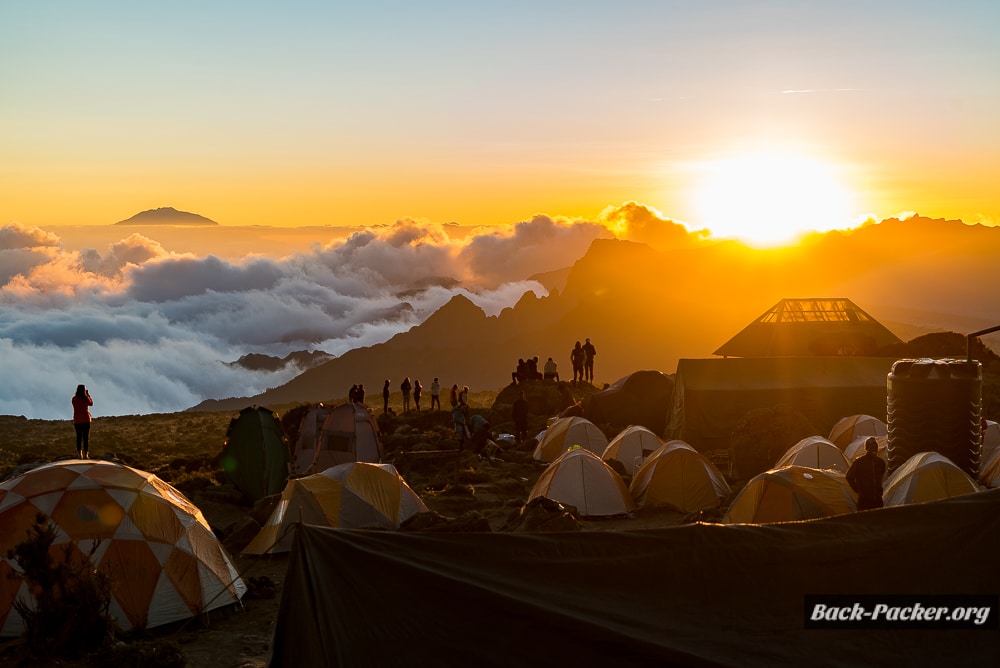
Disclaimer: As a brand ambassador for G Adventures I got invited on this trip in order to produce a video documentary in cooperation with G Adventures. This post contains Affiliate Links for services and products I’m using on my travels – therefore I can highly recommend them. By using these links you won’t pay any additional fees! All recommendations, Kilimanjaro tips, opinions, and ironic remarks are, as always, my own.

